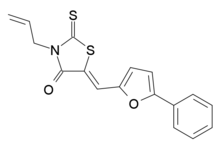LJ-001
LJ-001 is a broad-spectrum antiviral drug developed as a potential treatment for enveloped viruses. It acts as an inhibitor which blocks viral entry into host cells at a step after virus binding but before virus–cell fusion, and also irreversibly inactivates the virions themselves by generating reactive singlet oxygen molecules which damage the viral membrane. In cell culture tests in vitro, LJ-001 was able to block and disable a wide range of different viruses, including influenza A, filoviruses, poxviruses, arenaviruses, bunyaviruses, paramyxoviruses, flaviviruses, and HIV.[1] Unfortunately LJ-001 itself was unsuitable for further development, as it has poor physiological stability and requires light for its antiviral mechanism to operate.[2] However the discovery of this novel mechanism for blocking virus entry and disabling the virion particles has led to LJ-001 being used as a lead compound to develop a novel family of more effective antiviral drugs with improved properties.[3][4]
 | |
| Identifiers | |
|---|---|
| |
| CAS Number | |
| PubChem CID | |
| ChemSpider | |
| UNII | |
| Chemical and physical data | |
| Formula | C17H13NO2S2 |
| Molar mass | 327.420 g·mol−1 |
| 3D model (JSmol) | |
| |
| |
See also
References
- Wolf MC, Freiberg AN, Zhang T, Akyol-Ataman Z, Grock A, Hong PW, et al. (February 2010). "A broad-spectrum antiviral targeting entry of enveloped viruses". Proceedings of the National Academy of Sciences of the United States of America. 107 (7): 3157–62. Bibcode:2010PNAS..107.3157W. doi:10.1073/pnas.0909587107. PMC 2840368. PMID 20133606.
- The Rise and Fall of LJ-001. Memoirs of a Defective Brain, 19 August 2013
- Vigant F, Lee J, Hollmann A, Tanner LB, Akyol Ataman Z, Yun T, et al. (2013). "A mechanistic paradigm for broad-spectrum antivirals that target virus-cell fusion". PLOS Pathogens. 9 (4): e1003297. doi:10.1371/journal.ppat.1003297. PMC 3630091. PMID 23637597.
- Hollmann A, Castanho MA, Lee B, Santos NC (April 2014). "Singlet oxygen effects on lipid membranes: implications for the mechanism of action of broad-spectrum viral fusion inhibitors". The Biochemical Journal. 459 (1): 161–70. doi:10.1042/BJ20131058. PMID 24456301.